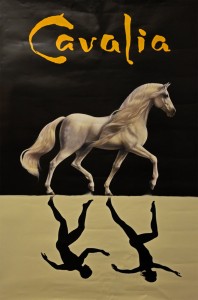Cavalia | The Entertainment Quarter
- June 15th, 2013
- Posted in Reviews & Responses
- Write comment

Australians love horses judging by the influx of horse themed shows on in Sydney at the moment – War Horse (currently at the Sydney Lyric theatre) advertisements splashed over the backs of taxis and Cavalia on nearly every billboard and flagpole in the city – and of course, every November there is a “race that stops the nation.” Yes. We love horses. And we have a long history of love with horses:
Who can deny our history with horses in film?
Man From Snowy River, anyone?
And what about the spectacle of horses in early Australian theatre?
Here I site Robbery Under Arms by Alfred Dampier (Check out the play via Currency Press HERE) a great example (here’s the FILM trailer…)
A hundred years ago, horses were regarded as a part of entertainment and it still seems true with Cavalia’s dominance and extended-season success.
“Cavalia is a fresh mix of equestrian and performing arts, multimedia and special effects. Conceived by Normand Latourelle and often labelled an equestrian ballet, Cavalia is a spectacular and moving tribute to the relationship between human and horses throughout history, a dream of freedom, cooperation and harmony. In a fairy tale setting filled with poetry and emotion, the show innovatively integrates acrobatics, dance, aerial stunts, live music and equestrian arts. Under the White Big Top, a 50-metre stage permits the horses to express themselves in all their splendour, nobility and strength, often completely free.”
Despite growing up in country NSW, my relationship with horses is somewhat aloof. Though my hometown had it’s own pony club (See proof HERE) I was not a part of that world – so I come to this as someone curious about spectacle – about the idea of “equestrian ballet” beyond the confines of an Olympic dressage competition and intersected with multimedia and acrobatic elements: a fascinating premise in anyone’s books. How could I resist?
An imported show from the pioneering mind/practice of Cirque du Soleil co-founder Normand Latourelle, Cavalia has enjoyed international success (attended by over 3.5 million people) over many years (it premiered ten years ago) before making it to Australia. The scale is impressive: 50 horses, 42 riders/performers, on a 50 metre wide stage and the opening slide presentation quizzing the audience on the impressive statistics of the production are indeed mesmerizing and awe-inspiring (The logistics alone are enough to garner applause.)
The opening sequence showing a filmed “birth” of a horse in soft focus romanticized the trembling, shaky-legged beginnings – which for a “birth” at the beginning (dramaturgically) has a depressing and obvious conclusion (death). Lucky for us, there is no narrative, nor any through line except for “horses are wonderful” to carry the spine of the show.
Strangely enough all the work Cirque du Soleil had done through their history to re-imagine and re-inspire circus through human performance and design is somewhat undone in Cavalia. The animal has been returned to circus, it seems. Despite the premise celebrating the freedom and the symbol of “the horse” as a powerful animal of strength and endurance, here we see the horse as a platform for leaping and backflipping or as highly manipulated and subdued following near “invisible” cues from a trainer. This then becomes a celebration, not of the horse, but of the skill in mastering the horse – working the horse to fulfill a format of “circus” or “performance” – which frankly seemed a little depressing. We have tamed the wild and powerful force of the horse for our own entertainment. We have relegated nature to domestic trick-turning.
What is there to celebrate?
The obedience of an animal no longer connected to it’s power?
More strangely the confusing cultural positioning of the show made me feel like this was a generic re-imagining of culture: somewhat middle eastern music, with projected quotes from the Quran wafting above the floor met medieval English costuming which seemed to celebrate hair and manes.
Lastly the resulting sense I received was that this work was appealing to our nostalgic sense of disconnection with the natural world: the possibilities/hidden unrealised potential of our bodies (most audience members don’t back flip their way through life) and the novelty of seeing a large animal unharnessed/harnessed in real life. There is something innate which holds both in wonder and awe, and again I found that deflating more than inspiring.
The moments I found most interesting was when one of the horses was biting another horse which John Shand describes as “six unharnessed Andalusians performed a series of charmingly balletic manoeuvres under the horse-whispering direction of Keith Dupont.”
Read more HERE
And I enjoyed the moment of seeing a shetland pony run across the performance space. Because it is novel to see a shetland pony. Or any pony. Or horse. And it is a novelty. But is it innovation?
For your enjoyment (PLEASE NOTE, THIS IS NOT IN CAVALIA)
(NB One of the YouTube comments is “It’s well know fact….Ponies can sell anything” and in the case of Cavalia this certainly seems true)
Cavalia
Venue: Under the White Big Top, Entertainment Quarter, Moore Park NSW
Dates: from May 15, 2013
Tickets: Adults $64 – $164 (Children, junior, senior and VIP tickets available)
Bookings: 1800 765 955
Visit: www.cavalia.com.au